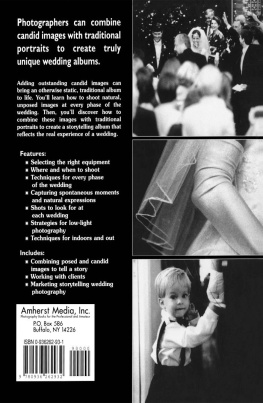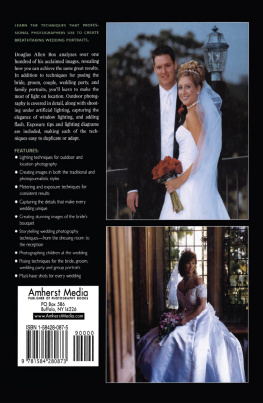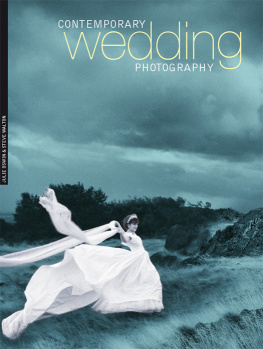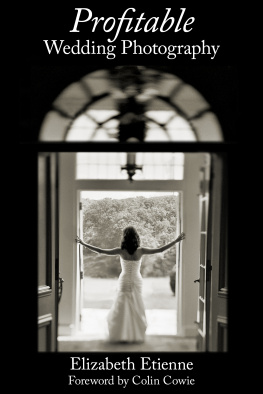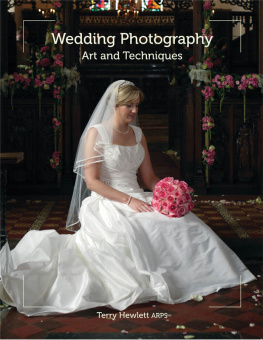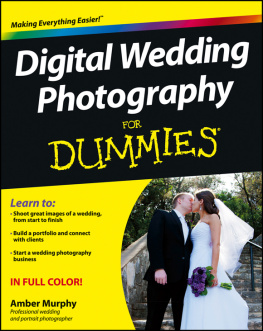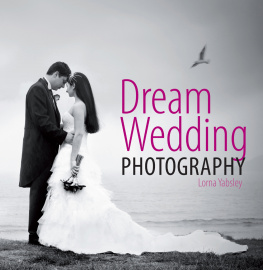
STORYTELLING
WEDDING
P HOTOGRAPHY
Techniques and Images in Black & White

Dedication
I would like to thank my parents, for without them, nothing in my life would exist. I also need to thank my special niece, Meaghan McCafferty, for helping me get started on this project, and for helping me with my early editing.
A special thanks to my husband, Doug, for without our marriage, photography would never have been my career. Without his urging, I would never even have thought about writing a book. Without his love and encouragement, I would never have gotten up in front of an audience to share my thoughts and ideas on Storytelling Photography.
Copyright 2000 by Barbara Box.
All photographs by Barbara Box and Douglas Box.
All rights reserved.
Published by:
Amherst Media, Inc.
P.O. Box 586
Buffalo, N.Y. 14226
Fax: 716-874-4508
Publisher: Craig Alesse
Senior Editor/Project Manager: Michelle Perkins
Assistant Editor: Matthew A. Kreib
Scanning Technician: John Gryta
ISBN: 0-936262-93-1
Library of Congress Card Catalog Number: 98-74595
Printed in the United States of America.
10 9 8 7 6 5 4 3 2
No part of this publication may be reproduced, stored, or transmitted in any form or by any means, electronic, mechanical, photocopied, recorded or otherwise, without prior written consent from the publisher.
Notice of Disclaimer: The information contained in this book is based on the authors experience and opinions. The author and publisher will not be held liable for the use or misuse of the information in this book.
Thank you for investing in this book. In it, you will learn my interpretation of wedding photography. Some of you reading this may have many years of experience on me, but this book is less about technique, and more about vision. It is about seeing wedding photography in a new and different light.
When I first arrive at a wedding and begin photographing, I try to put myself in the brides state of mind. I ask myself certain questions from her perspective. What does she think is important? What will she want to remember? How can I tell a story of her wedding that will capture the day the way she always dreamed it would be? By getting into that state of mind, I get into the zone, and put myself in a state of mind that allows me to be creative and see like a bride. After all, she is the one who must be pleased with the final product.
This book is the result of trying to see like a bride and capture the special moments and details which often go unnoticed in the larger picture of the day. These little things reveal the story behind the story and paint a picture of the wedding as the bride dreamed of it for years, and experienced it on that day.
THESE IMAGES CAN BE COMBINED WITH TRADITIONAL PHOTOGRAPHY OF THE WEDDING
In the first part of the book, I will discuss the techniques I use to capture these genuine moments and details. In the second section, I will demonstrate how these images can be combined with traditional photography of the wedding (posed photography of the couple, their family and wedding party), to create a fuller picture of the wedding day than most albums.
It is a style of photography that demands quick thinking and an unflinching knowledge of ones equipment, but one which also offers exciting possibilities to wedding photographers and their clients.

This type of image defines my style: a moment, a snippet of the whole story, and yet a story in itself. It was a fleeting moment in this young mans life as he attended his aunts wedding.
The fine young fellow was about to walk down the aisle with his mom, who was a bridesmaid. I squatted down to shoot from a more interesting angle. Detecting motion, the boy turned his head, and delicately touched his fingers to his face. With a click, I captured this special moment. I couldnt have posed it; the image was just a fleeting moment that I had to be present and ready to capture.
A MOMENT, A SNIPPET OF THE WHOLE STORY, AND YET A STORY IN ITSELF.
In addition to the indicative unposed aspect of this image, this portrait also reveals the importance of modern photographic technology to this style. Auto-focus, matrix metering, fast film and fast lenses all allow me the freedom to work quickly and efficiently all crucial aspects for successful storytelling photography.

Photography tells two stories: the story of the subject who is photographed and the story of the photographer. This second story is often overlooked, but should not be so easily dismissed. Just as the choices we make in our lives are clearly influenced by our personality, history, education, etc., so too are these influences reflected in the subjects we choose to photograph and how we execute a portrait of that subject.

For instance, as a woman and a former bride, I am quite aware of all the fine tuning that goes into choosing the little details like the perfect stockings, the right undergarments to make the dress hang perfectly, etc. The importance of these details might never occur to someone who had never experienced them. On the other hand, another person might also see something different than I do, or choose to capture it in a different way than I do.
Our visions are unique and personal. To help you understand how I approach these subjects, I have provided a little background on the influences that have helped define my style.
As you may have read in the dedication of this book, photography was not a career I pursued from the start of my life. Still, I knew an artistic career was in my future. I loved to draw and Friday afternoons at St. Marys Elementary School in Dedham, Mass., were my favorite, because it was time to do art!
As my education progressed, I still felt most comfortable in my art classes. I continued to college and studied at the Boston Architectural Center for three years. While the bills were paid, it was wonderful, but eventually I realized I had to take inventory, and start working again, full time. I was devastated when I was forced to quit school, because I really felt that architecture was where I belonged.
But, as one door closes, another opens. After many years of working on my life, and enjoying architecture as a hobby instead of a career, I met a wonderful man, now my husband, Douglas Box. He is a Master Photographer, Kodak Mentor, speaker in the photographic industry and the Executive Director of the Texas Professional Photographers Association. As you can well imagine, our relationship required me to live a crash course in photography.
After we married in 1996, I started working in the studio, designing wedding albums, and doing just about any other job he did not want or have time to do. I also assisted in weddings-running for lenses, changing film and fluffing dresses. I didnt complain about this aspect of the work, because it was how we made our living. But I did complain about attending receptions.
Next page
